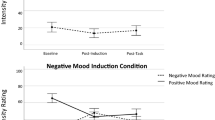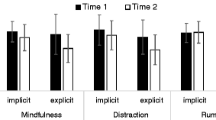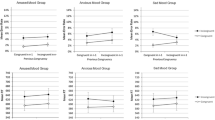Abstract
Previous research demonstrates that individuals in a positive mood are differentially distracted by irrelevant information during an ongoing task (Rowe et al. in Proc Natl Acad Sci 104:383–388, 2007). The present study investigated whether susceptibility to distraction shown by individuals in a positive mood results in greater implicit memory for that distraction. Participants performed a similarity-judgment task on pictures that were superimposed with distracting words. When these previously distracting words could be used as solutions on a delayed implicit task administered several minutes later, performance was positively correlated with pleasantness of mood. Individuals in a positive mood are more likely than others to use previously irrelevant information to facilitate performance on a subsequent implicit task, a finding with implications for the relationship between positive mood and creativity.

Similar content being viewed by others
Notes
The removal of this participant from the data set did not change any statistical outcomes.
References
Bäuml, K.-H., & Kuhbandner, C. (2009). Positive moods can eliminate intentional forgetting. Psychonomic Bulletin & Review, 16, 93–98.
Campbell, K. L., Hasher, L., & Thomas, R. C. (2010). Hyper-binding: A unique age effect. Psychological Science (Advance online publication). doi:10.1177/0956797609359910.
Carson, S. H., Peterson, J. B., & Higgins, D. M. (2003). Decreased latent inhibition is associated with increased creative achievement in high-functioning individuals. Journal of Personality and Social Psychology, 85, 499–506.
Carvalho, J. O., & Ready, R. E. (2009). Emotion and executive functioning: The effect of normal mood states on fluency tasks. Journal of Clinical and Experimental Neuropsychology (Advance online publication). doi:10.1080/13803390902902458.
Carver, C. S. (2003). Pleasure as a sign you can attend to something else: Placing positive feelings within a general model of affect. Cognition & Emotion, 17, 241–261.
Corsi, P. M. (1972). Human memory and the medial temporal region of the brain. Dissertation Abstracts International, 34(02), 819B. (UMI No. AA105-77717).
Dreisbach, G., & Goschke, T. (2004). How positive affect modulates cognitive control: Reduced perseveration at the cost of increased distractibility. Journal of Experimental Psychology: Learning, Memory, and Cognition, 30, 343–353.
Easterbrook, J. A. (1959). The effect of emotion on cue utilization and the organization of behavior. Psychological Review, 66, 183–201.
Eriksen, B. A., & Eriksen, C. W. (1974). Effects of noise letters upon the identification of a target letter in a nonsearch task. Perception & Psychophysics, 16, 143–149.
Fenske, M. J., & Eastwood, J. D. (2003). Modulation of focused attention by faces expressing emotion: Evidence from flanker tasks. Emotion, 3, 327–343.
Fredrickson, B. L. (2001). The role of positive emotions in positive psychology: The broaden-and-build theory of positive emotions. American Psychologist, 56, 218–226.
Hasher, L., Zacks, R. T., & May, C. P. (1999). Inhibitory control, circadian arousal, and age. In D. Gopher & A. Koriat (Eds.), Attention and performance XVII: Cognitive regulation of performance (pp. 653–675). Cambridge, MA: MIT Press.
Ikier, S. (2005). Age differences in implicit interference. Unpublished doctoral dissertation, University of Toronto, Toronto, ON.
Isen, A. M., Daubman, K. A., & Nowicki, G. P. (1987). Positive affect facilitates creative problem solving. Journal of Personality and Social Psychology, 52, 1122–1131.
Isen, A. M., Johnson, M. M., Mertz, E., & Robinson, G. F. (1985). The influence of positive affect on the unusualness of word associations. Journal of Personality and Social Psychology, 48(6), 1413–1426.
Jefferies, L. N., Smilek, D., Eich, E., & Enns, J. T. (2008). Emotional valence and arousal interact in attentional control. Psychological Science, 19, 290–295.
Kim, S., Hasher, L., & Zacks, R. T. (2007). Aging and benefit of distractibility. Psychonomic Bulletin & Review, 14, 301–305.
May, C. P. (1999). Synchrony effects in cognition: The costs and a benefit. Psychonomic Bulletin & Review, 6, 142–147.
Mayer, J. D., & Gaschke, Y. N. (1988). The experience and meta-experience of mood. Journal of Personality and Social Psychology, 55, 102–111.
Mednick, M. T., Mednick, S. A., & Mednick, E. V. (1964). Incubation of creative performance and specific associative priming. Journal of Abnormal and Social Psychology, 69, 84–88.
Phillips, L. H., Bull, R., Adams, E., & Fraser, L. (2002). Positive mood and executive function: Evidence from Stroop and fluency tasks. Emotion, 2, 12–22.
Rees, G., Russell, C., Frith, C. D., & Driver, J. (1999). Inattentional blindness versus inattentional amnesia for fixated but ignored words. Science, 286, 2504–2507.
Rowe, G., Hirsh, J. B., & Anderson, A. K. (2007). Positive affect increases the breadth of attentional selection. Proceedings of the National Academy of Sciences, 104, 383–388.
Rowe, G., Valderrama, S., Hasher, L., & Lenartowicz, A. (2006). Attentional disregulation: A benefit for implicit memory. Psychology and Aging, 21, 826–830.
Schmitz, T. W., De Rosa, E., & Anderson, A. K. (2009). Opposing influences of affective state valence on visual cortical encoding. The Journal of Neuroscience, 29, 7199–7207.
Snodgrass, J. G., & Vanderwart, M. (1980). A standardized set of 260 pictures: Norms for name agreement, image agreement, familiarity, and visual complexity. Journal of Experimental Psychology: Human Learning and Memory, 6, 174–215.
Vosburg, S. K. (1998). The effects of positive and negative mood on divergent-thinking performance. Creativity Research Journal, 11, 165–172.
Acknowledgments
This work was supported by a grant from the National Institute on Aging (R37 AGO4306) and by a Canadian Institutes of Health Research grant (MOP89769). We thank Gillian Rowe for helpful advice on the design of this study.
Author information
Authors and Affiliations
Corresponding authors
Rights and permissions
About this article
Cite this article
Biss, R.K., Hasher, L. & Thomas, R.C. Positive mood is associated with the implicit use of distraction. Motiv Emot 34, 73–77 (2010). https://doi.org/10.1007/s11031-010-9156-y
Published:
Issue Date:
DOI: https://doi.org/10.1007/s11031-010-9156-y




